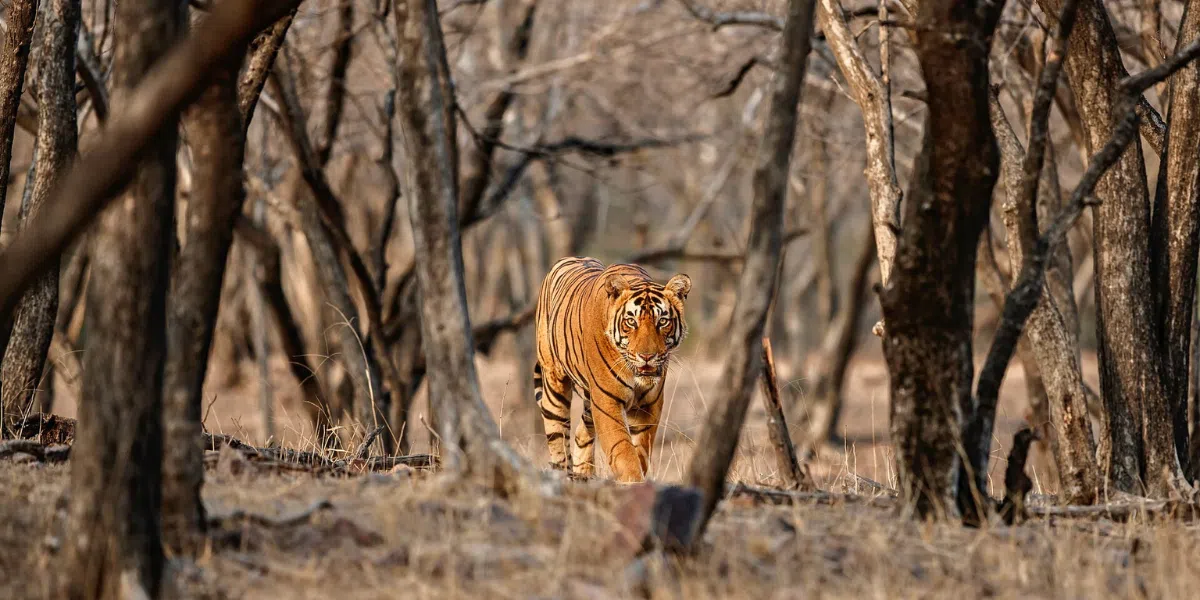All of India is home to the renowned Royal Bengal Tiger, except for the cold desert of the Trans-Himalayan areas in the north and the hot desert areas of West India. With a rich mythical and anthropological background, it is a representation of power and dignity among the Indian populace.
The magnificent tiger is a dream animal for many nature and wildlife enthusiasts today, and India is the only country where they might witness one on a safari. There are currently 50 Tiger Reserves in India, and because of the country’s stringent wildlife laws and protection measures, the animals there are properly safeguarded.
Look at some fascinating facts about the Royal Bengal Tiger and discover the adaptations that have helped it become the top predator in the Indian Subcontinent over thousands of years.
IUCN Status of the symbolism of strength: Endangered
Officially, there are 3167 tigers in India (2022 All-India Census). Compared to the All-India Tiger Census of 2018, which found that there were 2967 tigers in the wild in India, this is a significant increase.
Data show that the habitat of Bengal tigers is rapidly diminishing, hence the reasons for the rise in population can only be attributed to better counting methods and bigger survey regions.
While we commend the field workers for their efforts to prevent poaching. The present threshold limit for the Tiger in India is met, and there is more that officials in India might do to raise it. It is challenging to anticipate a growth in the existing figures.
Tiger’s Adaptations
- A Royal Bengal Tiger’s orange coat and black stripes, which are absorbed by the sun’s rays that filter through, aid in breaking the shadows cast by the trees as the tiger moves through the forest. In the grasslands, it is also useful for stalking.
- Bengal tigers have extra sensory organs in their vibrissae, or whiskers, which allow them to detect motion and the presence of other animals.
- Similar to other vertebrates, Bengal tigers possess an olfactory gland called the Jacobson’s organ, which is located around the palate of the mouth. This gland allows them to detect the presence of other tigers by scent, scat, and urine.
- Royal Bengal tigers can retract their claws, which keeps them sharp and allows them to use them sparingly.
- There is a noticeable space that separates the Royal Bengal Tiger’s canines and molars, allowing it to hold its victim tightly while choking it to death.
- The Royal Bengal Tiger’s jaw muscles are directly linked to the top of their skulls; therefore, their bottom jaw can only move up and down, not side to side, which allows the tigers to maintain a firm hold on their prey.
- Prey animals that are significantly bigger and heavier than the Royal Bengal Tiger can be fatally bitten by them owing to their enormous head and powerful jaws.
- Bengal Tigers can travel through the forest without producing any noticeable noises as they have delicate and soft padding on their feet.
- Royal Bengal Tigers can leap up to 30 feet in a single stride as a result of their large hind legs, which provide them with spring and agility.
The Tiger’s Conduct
- Tigers are solitary animals; the only occasions when one can witness a “streak” of tigers are when a mother is with her cub(s) or when a male and female tiger are courting. On rare occasions, a family of tigers may also be seen when the male spends time visiting his cubs and guarding his territory.
- Even more unusual and intriguing stories have been documented with tigers that have had two litters: one with her subadults, who are about to go on the prowl, and another with her fresh litter of small cubs. In Central India’s Pench National Park, this is extensively documented.
- A male Royal Bengal tiger has a large home range that spans between 50 and 150 sq km. He fiercely defends this region, doing his utmost to keep other males, even his own adult progeny, out of it.
- There may be several female tigers, often two to four, in the males’ area or territory, with whom he mates sometimes to create his progeny.
- Due to their solitary nature, their hunting endeavours may require a significant investment of time and energy; yet, they do not mind feeding for food from other animals.
- To have a fair chance of capturing its prey, a Bengal Tiger should preferably be no more than thirty feet away from it. It is claimed that seven out of ten hunts are unsuccessful.
- Tigers’ quest for food is hampered by the ungulates’ great sense of smell and hearing, as well as by the monkeys’ vigilant eyes and ability to raise an alert in the case of a threat.
- However, tigers are extremely intelligent creatures that are designed for the kill. They take down enormous animals with their power and expertise.
- A large animal, such as sambar or nilgai, may sustain a tiger for two days, feeding at regular intervals and consuming up to 20 kg of flesh per day.
The Courtship Process
- The Bengal Tiger does not have a set breeding season.
- A female Royal Bengal tiger in oestrus marks her territory by leaving scent marks or sprays on trees that are visible and might be in the way of a male Bengal tiger. The Male Tiger can detect these urinal sprays’ strong fragrance and pheromones by sniffing them and utilising his Jacobson’s Organ to interpret the chemical cues they contain.
- A Tigress may also growl or yell in an attempt to get a male tiger close by. Another Tiger may hear these roars around 4 kilometres away.
- Occasionally, these signals lead to conflict since several male tigers who pick on this may collide and get into fights. And, these conflicts result in fatalities.
- As a result, females get to choose the stronger gene for their progeny.
- But, a mother tiger is not always in charge; if she is unable to guard the young, an intruding male tiger may murder the cubs. He performs them in the hopes of mating with her, as if her pups are killed, she could return to estrous very rapidly.
- To appease a male tiger that has invaded the territory of her cubs, a female Bengal tiger may also “falsely mate” with him. For as long as it takes for the serious threat to subside, she will stay with him.
- Usually staying together for a few days, a male and female Bengal tiger copiously mate in the hopes of becoming pregnant.
- Although it is a true mystery why some female tigers do not conceive despite numerous indications of mating, there are several possible explanations for this, including stress, competition with other tigers, and a lack of suitable habitat.
Being a Tiger’s Mother
- The average gestation period lasts between 100 and 115 days.
- In exceptionally rare instances, there may be two to five cubs in each litter. Although five cubs are born, most of them do not live to adulthood. The only known wild tiger to have successfully reared five cubs to adulthood is this living tale in the Pench National Park.
- After around five months of being given their mother’s milk, cubs are effectively weaned.
- The female tiger raises her cubs by herself, and her mission on hunting excursions is to hunt skillfully and conceal her babies well. Due to the challenging nature of the endeavour and the numerous threats that the defenceless cubs must overcome in their early years, the death rate is very high.
- Tigresses use the crevices between massive rocks and even the trunks of enormous fallen trees as makeshift hiding places or places to make their nests.
- As they age, they go with her around her native territory. Mastering her techniques and sharpening their talents. When she eventually starts taking them hunting with her, they observe as she expertly pursues her prey while being cautious not to reveal her presence. Her expectation of hunting more frequently increases with the growth of the cubs.
- While bringing down her victim, a female tiger will also seriously injure it; but, she will not bite it. She hands it over to the cubs, who now have to figure out how to put the poor animal to death. Then they have to learn how to rip the flesh apart and pull off the hair. As horrible as it may sound, every Tiger must master these vital survival abilities.
- By the time the cubs are between 18 and 22 months old, the mother progressively stops feeding them and starts to act more aggressively against them. At this point, she chases them out of her territory, ending their need or their reliance on her. Now that they are on their own, a life of solitude awaits them as they fight to survive and create their territories. Hopefully, by then, they would have conducted a few successful solo hunts.
- Male subadults often disperse more quickly and cover greater ground to establish a territory than their sisters.
Global Subspecies of Tigers
- The world’s tigers comprise nine subspecies.
- Three out of nine species are extinct in the wild, and the fourth is most likely also gone.
- There are about 4,000 tigers worldwide, belonging to nine different subspecies.
Siberian or Amur Tiger
Panthera Tigris Altaica
- Weight: 180kg – 320 kg
- Length: Upto 11 feet
- Population: 400-500 individuals
- Distribution: Russia
Royal Bengal Tiger
Panthera Tigris
- Weight: 130 kg – 280 kg
- Length: Upto 10.5 feet
- Population: 2000 – 2500 individuals
- Distribution: India, Nepal & Bangladesh
Caspian Tiger
Panthera Tigris Virgata
- Weight: 100 kg – 240 kg
- Length: Upto 10.5 feet
- Population: Extinct
- Distribution: Iran, Iraq, Afghanistan
Indo-China Tiger
Panthera Tigris Corbetti
- Weight: 150 kg – 195 kg
- Length: Upto 10 feet
- Population: 200 – 250 individuals
- Distribution: China, Burma, Thailand, Cambodia, Myanmar
South China Tiger
Panthera Tigris Amoyensis
- Weight: 110kg – 175kg
- Length: Upto 9 feet
- Population: Functionally Extinct
- Distribution: China
Javan Tiger
Panthera Tigris Sondaica
- Weight: 75 kg – 140 kg
- Length: Upto 8.5 feet
- Population: Extinct
- Distribution: Java – Indonesia
Sumatran Tiger
Panthera Tigris Sumatrae
- Weight: 75 kg-140 kg
- Length: Upto 08 feet
- Population: 400-800 individuals
- Distribution Sumatra: Indonesia
Balinese Tiger
Panthera Tigris Balica
- Weight: 65 kg – 100 kg
- Length: Upto 7 feet
- Population: Extinct
- Distribution: Bali – Indonesia

